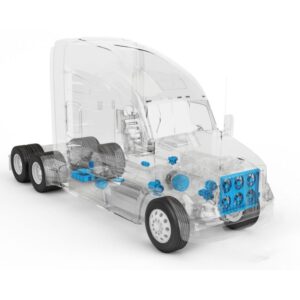Commercial Vehicles Seek Electric Option
This article may contain affiliate links.
[Ed note: This article was orginally written in 2009 in the early days of electrification, but the same ideas are coming around again–with some similar nomenclature–as General Motors launches BrightDrop and Rivian produces vans for Amazon, and the USPS finally gets the funding to get serious about electrifying its fleet.]
A growing number of commercial customers are eager to buy plug-in hybrids from Toyota, Chevy, Ford, Fisker and others that are completing new manufacturing for initial 2010 orders and serious competition in 2011. Oil prices have doubled from their low this year. People are planning to save on fuel for years, by using more inexpensive electricity and less gasoline.
Fuel costs millions for the delivery and service fleets that bring us our mail and goods and keep our cities running. About one million new vans are purchased annually in North America.

For years, the United States Postal Service (USPS) has piloted electric vehicles in its fleet of over 200,000 delivery vehicles. Azure created custom electric vehicles for the post office.
Ford is starting to take orders from municipalities and other government agencies that will use the new Transit Connect light-duty van in a variety of applications from city maintenance to on-demand transit. Deliveries of these electric vehicles will start by the end of 2010. Transit Connect may also do well with small businesses and local delivery fleets. See the Clean Fleet Ford Report.
South Coast Air Quality Management District has helped fleets achieve significant mileage gains with Sprinter Vans converted to be plug-in hybrid.
Utility Help
The electric utilities that will help power these plug-ins often have thousands of vehicles in their fleet. Utilities have turned to companies like Eaton to double the mileage of their trouble trucks with hybrid and plug-in hybrid drive systems. Ford F-550s were first converted into hybrids and now into plug-in hybrid trouble trucks. In addition to using less diesel fuel, these trucks can run all their accessories electrically. Previously, they had to idle the truck engine for hours to host a repair technician into the air, to run repair equipment, and all auxiliaries.

The Eaton hybrid-electric drive system will be used in 138 FedEx delivery vans. In New York alone, FedEx deployed 48 E700 Eaton hybrids. Check out the Clean Fleet FedEx Report. Local delivery vans can particularly benefit in fuel savings by capturing braking energy with frequent stops, by establishing a central charging infrastructure, and by having mid-day opportunities for recharging in between morning pick-ups and afternoon deliveries.
Eaton Corporation’s truck and electrical businesses will support a $45.4 million grant to develop a fully integrated plug-in hybrid systems for Class 2 to 5 vehicles, weighing up to 19,500 pounds, according to a Green Car Congress report. A demonstration fleet of 378 plug-in hybrid trucks and shuttle buses will be put into use.
Plug-in vans and trucks can have a major impact on U.S. oil dependency. Federal, state, and local fleets own four million vehicles. Corporations have bigger total fleets. There is great interest in extending the electric-range of vehicles. Most attention has been placed on battery improvements. A more practical way to extend range is to make vehicles more aerodynamic and lighter.
A “Bright” Idea
Bright Automotive wants to make 50,000 plug-in hybrid vans per year that are built from the ground-up to deliver 100 mpg in a van that can carry 180 cubic feet of cargo. A typical conventional van carrying such load might achieve 15 mpg. This spin-off of the Rocky Mountain Institute has major strategic partners including Alcoa, Johnson-Controls and Google. The Bright IDEA van weighs only 3,200 pounds, less than a Prius, and can go 30 miles on battery power alone. It will be stronger than steel, yet built with light-weight aluminum and composite material like the Tesla. With a sub-.30 drag coefficient, the van only needs a 10 kilowatt-hour lithium-ion battery pack. In demanding delivery applications, each Bright IDEA could save $6,000 per year in fuel alone.
Bright is currently doing a project for the U.S. Department of Defense that involves converting a VW Transporter to be a plug-in hybrid. Bright hopes to secure a federal loan to build a manufacturing plant in Indiana to build the new light aerodynamic vans in volume.
Fleets are taking the lead in energy security and reduced emissions with fleets of hybrids, plug-in hybrids and full electric vehicles.
If you’re considering plug ins but have no way to get a fleet to where you are, you can use a vehicle transporting company like a1autotransport who can get any amount of vehicles to almost anywhere in the entire world.
By John Addison (updated 12/13/22 by Michael Coates; original 10/5/09).
